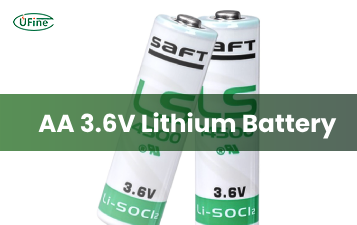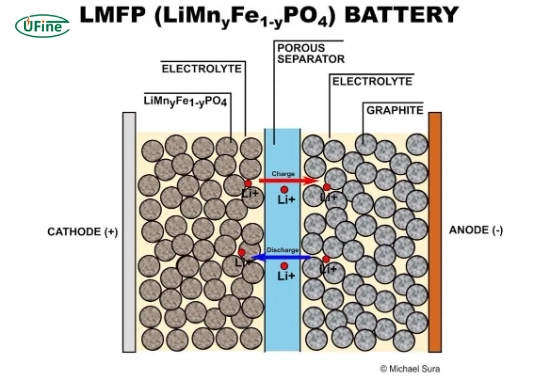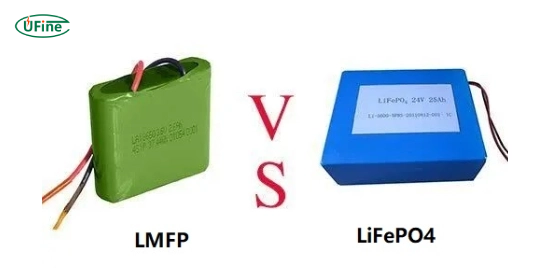Have you ever heard of an LMFP battery and wondered what all the hype is about? Well, you’re in the right place. This guide dives deep into the world of Lithium Manganese Iron Phosphate (LMFP) batteries, exploring everything from their essential components to their potential to revolutionize the electric vehicle (EV) industry and beyond. So buckle up and get ready to explore the next generation of lithium battery technology!
Part 1. What is an LMFP battery?
Let’s start with the basics. An LMFP battery is a souped-up version of the Lithium Iron Phosphate (LFP) battery. Think of it as LFP’s more incredible, more capable cousin. The key difference? LMFP batteries incorporate manganese into their cathode material.
The Chemistry: In an LMFP battery, some iron in the LFP cathode is replaced with manganese (LiMnFePO4). This seemingly small change significantly impacts the battery’s performance.
Why Manganese? Manganese helps to improve the battery’s energy density and power capabilities.
In Simple Terms: An LMFP battery is a lithium-ion battery that uses lithium manganese iron phosphate as the cathode material. This gives it a unique blend of performance, safety, and cost-effectiveness.
Part 2. LMFP vs. LFP: What are the key differences?
So, how does an LMFP battery stack up against its predecessor, the LFP battery? Here’s a breakdown of the key differences:
| Feature | LFP Battery | LMFP Battery |
|---|---|---|
| Energy Density | Slightly lower | Higher (up to 20% more) |
| Operating Voltage | Lower | Higher |
| Cost | Generally lower | Slightly higher per kg, but potentially lower per watt-hour due to higher energy density |
| Lifespan | Longer (up to 6,000 cycles) | Slightly shorter (2,000-3,000 cycles before capacity drops below 75%) |
| Thermal Stability | Excellent | Excellent |
| Applications | Permanent storage, electric vehicles | Emergency power, mobile power stations, EVs with higher performance requirements |
| Material Usage | More iron per kWh for cathode material | More sustainable due to efficient use of materials (less iron, more manganese) |
In a nutshell, LMFP batteries offer a boost in energy density and performance, while LFP batteries excel in lifespan and cost-effectiveness.
Part 3. The advantages of LMFP batteries
What makes LMFP batteries so appealing? Here are some of their key advantages:
- Higher Energy Density: LMFP batteries can store more energy for their size and weight than LFP batteries. This is crucial for EVs, as it translates to longer driving ranges.
- Enhanced Safety: Like LFP batteries, LMFP batteries boast excellent thermal stability, reducing the risk of overheating and thermal runaway.
- Improved Power Output: LMFP batteries can deliver higher bursts of power, making them suitable for applications that demand quick acceleration and responsiveness.
- Sustainable Material Usage: LMFP batteries utilize materials efficiently, requiring less iron and more manganese, which is more abundant.
- Fast Charging Capabilities: LMFP batteries can be charged quickly, reducing downtime and enhancing convenience.
- Cost-Effective: Despite the added manganese, LMFP batteries can be more economical than other lithium-ion batteries due to their higher energy density and the potential for using lower-cost materials in production.
Part 4. Potential applications of LMFP batteries
LMFP batteries are not just limited to EVs. Their unique properties make them suitable for a wide range of applications:
- Electric Vehicles (EVs): LMFP batteries are gaining traction in the EV industry, offering a balance of range, safety, and cost. Tesla has already adopted LMFP batteries in some of their vehicles.
- Energy Storage Systems (ESS): LMFP batteries can be used in stationary energy storage systems for homes, businesses, and grid-scale applications.
- Emergency Power Supplies: Their high energy density and reliability make LMFP batteries ideal for emergency power backup systems.
- Mobile Power Stations: LMFP batteries can power portable power stations for camping, outdoor events, and construction sites.
- Aerospace: The high energy density and lightweight nature of LMFP batteries make them suitable for electric aircraft and drones.
Part 5. The challenges facing LMFP batteries
Despite their promising advantages, LMFP batteries still face some challenges:
- Conductivity: LMFP batteries can suffer from poor conductivity, limiting their performance.
- Lifespan Limitations: While still good, the lifespan of LMFP batteries is generally shorter than that of LFP batteries.
- Commercialization Hurdles: Reducing manganese dissolution at high temperatures and improving compaction density are ongoing challenges in commercializing LMFP battery technology.
Part 6. Overcoming the challenges: Innovations in LMFP technology
Researchers and manufacturers are actively working to overcome the challenges associated with LMFP batteries. Some of the key innovations include:
- Material Blending: Blending LMFP with other cathode materials like Nickel Cobalt Manganese (NCM) can create hybrid batteries with enhanced performance and cost-effectiveness.
- Ion Doping and Carbon Coating: These techniques can improve the electrochemical performance of LMFP batteries.
- New Manufacturing Processes: Exploring the use of powdered manganese-iron ore and phosphoric acid in manufacturing can help reduce costs.
- Granulation Technology and Electrolyte Additives: These advancements aim to improve the performance and stability of LMFP batteries.
Part 7. The future of LMFP batteries
The future looks bright for LMFP batteries. As technology advances and costs decrease, LMFP batteries are poised to dominate the battery market.
- Increased Adoption in EVs: Expect more electric vehicles to adopt LMFP batteries as manufacturers seek to balance performance, safety, and cost.
- Growth in Energy Storage: LMFP batteries will be crucial in expanding renewable energy by providing reliable and affordable energy storage solutions.
- New Applications Emerging: As the technology matures, we can expect to see LMFP batteries in more diverse applications, from aerospace to portable electronics.
- Competition and Innovation: The growing demand for LMFP batteries will drive further innovation and competition, leading to better performance and lower costs.
Artikel Terkait: LMFP Battery Market Outlook: Will It Replace LFP and NMC?
Part 8. How to choose the right battery: LMFP or LFP?
With both LMFP and LFP batteries offering unique advantages, how do you choose the right one for your needs? Here’s a simple guide:
- Choose LFP if you prioritize a long lifespan, lower cost, and are less concerned about maximum energy density.
- Choose LMFP if you need higher energy density and better power output and are willing to pay more.
- Consider your specific application and weigh the pros and cons of each technology to make the best decision.
Part 9. FAQs
-
What is the lifespan of an LMFP battery?
An LMFP battery lasts 2,000 to 3,000 cycles before its storage capacity falls below 75%. -
Are LMFP batteries safe?
Yes, LMFP batteries are considered safe due to their excellent thermal stability. Compared to some other lithium-ion battery chemistries, they are less prone to overheating or thermal runaway. -
Are LMFP batteries more expensive than LFP batteries?
LMFP batteries may have a slightly higher cost per kg, but their higher energy density can make them more cost-effective per watt-hour. -
What are the main applications of LMFP batteries?
LMFP batteries are used in electric vehicles, energy storage systems, emergency power supplies, mobile power stations, and aerospace applications. -
What are the advantages of LMFP batteries over other lithium-ion batteries?
LMFP batteries offer a combination of higher energy density, enhanced safety, improved power output, sustainable material usage, and fast charging capabilities.
Related Tags:
More Articles

What You Need to Know About AA 3.6V Lithium Battery
Learn all about AA 3.6V lithium batteries—voltage, size, capacity, uses, and the best replacements. Discover why they’re powerful, and highly reliable.
What Are Lithium Salts and Why They Matter in Battery Electrolytes
Lithium salts in electrolytes are key to battery performance, powering everything from phones to EVs and shaping the future of clean energy.
Lithium AAA Battery Guide: Power, Performance & Chargers
Explore lithium AAA batteries—voltage, capacity, weight, top brands, and more. Learn how to choose the best battery for your device and why it really matters.
How to Calculate Watts, Volts, and Amps (With Simple Formulas and Examples)
Learn how to calculate watts, volts, and amps for lithium batteries with simple formulas and examples, ideal for EVs, solar, and energy systems.
Comprehensive Analysis of U.S. Tariffs on Chinese Lithium Batteries
U.S. tariffs on Chinese lithium batteries in 2025 impact costs, supply chains, and EV, energy storage, and electronics industries globally.





